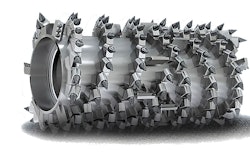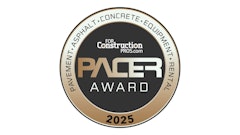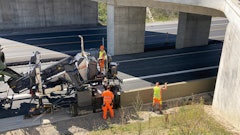
The Wisconsin Department of Transportation (WisDOT) has calculated a savings of $1,465,753 this year related to four projects that used the innovative cold-in-place recycling method for pavement rehabilitation.
Cold-in-place recycling mills the existing asphalt road surface and processes the material on-site for reuse by way of a convoy of equipment that crushes, adds new liquid asphalt and paves simultaneously. A total of 28.47 centerline miles of road were resurfaced using cold-in-place recycling this year, leading to an estimated on-site reuse of 93,450 tons of material – enough to fill more than 4,600 quad-axle dump trucks.
"With cold-in-place recycling, we’re reducing the cost to taxpayers while also cutting down on project time and the associated delays for drivers," said Barry Paye, engineering chief in the Materials Management Section of WisDOT’s Bureau of Technical Services. "To put it in perspective, we would have had enough dump truck loads of material from this year’s projects to stretch a line of dump trucks more than 22 miles. That’s important, because as those trucks stay parked, we save on fuel and create less wear and tear for our highways."
As with any technique, cold-in-place recycling works best under optimal conditions. It’s best suited for roadways where the pavement surface is worn and cracked but the subgrade below is still firm and in good shape. WisDOT has used the technique in seven different road projects statewide since 2012, and continued monitoring so far has shown favorable results compared to traditional resurfacing methods.
Where cold-in-place recycling has been used, numerous benefits have been identified, including:
- Reduction in project time, which reduces delays and inconvenience to road users.
- Reducing the need for material hauling and significantly reducing trucking costs.
- Reduction in the need to purchase and use new materials.
- Lower initial cost and typically lower maintenance needs compared to traditional method.
- Reduction in cracking because of increased durability.
The four cold-in-place recycling projects this year included:
- WIS 27 from Sparta to Black River Falls in Jackson County
- WIS 72 from Ellsworth to Elmwood in Pierce County
- WIS 13 from Medford to Westboro in Taylor County
- WIS 187 from Shiocton to North County Line in Outagamie County
Previous CIR projects completed include:
- WIS 48 from Grantsburg to Frederick in Burnett/Polk counties — constructed in 2012
- WIS 64 from Medford to Gilman in Taylor County — constructed in 2014
- WIS 48 from Rice Lake to Birchwood in Barron County — constructed in 2015
- WIS 95 from Blair to Merrillan in Trempealeau County — constructed in 2015
- County H from Reedsburg to Wisconsin Dells in Sauk County — constructed in 2015
WisDOT has been making annual evaluations of field data from cold-in-place recycling projects. Based on results gained so far, cold-in-place recycling has shown better performance against cracking compared to the mill and overlay sections.
WisDOT’s first cold-in-place recycling project, WIS 48 from Grantsburg to Frederick in Burnett/Polk counties, provides the most data on the quality of the method. When compared to the conventional mill and overlay section, cold-in-place recycling has reduced cracking by 90% and has a 15% better pavement performance rating. WisDOT’s second cold-in-place recycling project, WIS 64 from Medford to Gilman in Taylor County, also is demonstrating a 90% reduction in cracking when compared to the standard mill and overlay method.
Planning is ongoing to include more cold-in-place recycling projects in next year’s improvement schedule.







![[VIDEO] Watch Good Hope Contractors Use Road Widener](https://img.forconstructionpros.com/files/base/acbm/fcp/image/2016/09/default.57d6ccff4d8f7.png?auto=format%2Ccompress&fit=crop&h=167&q=70&w=250)











